Investigating Social Media's Influence on Entrepreneurial Intentions
VerifiedAdded on 2023/03/31
|92
|21200
|169
Thesis and Dissertation
AI Summary
This dissertation investigates the impact of social media on the development of entrepreneurial intentions among students. It examines the role of social media in shaping self-presentation, influencing entrepreneurial intentions, and the moderating effects of age. The research employs a positivism philosophy, deductive approach, descriptive design, and survey research strategy, collecting primary data from 100 students using a quantitative data analysis technique. Findings reveal a significant positive correlation between social media usage and entrepreneurial intentions, with students utilizing platforms like Facebook, Instagram, Twitter, YouTube, and LinkedIn to explore business ideas and stay informed about industry trends. The dissertation includes a literature review, research methodology, data analysis, and conclusions, offering recommendations for future research and highlighting the importance of social media in fostering entrepreneurial aspirations among students.
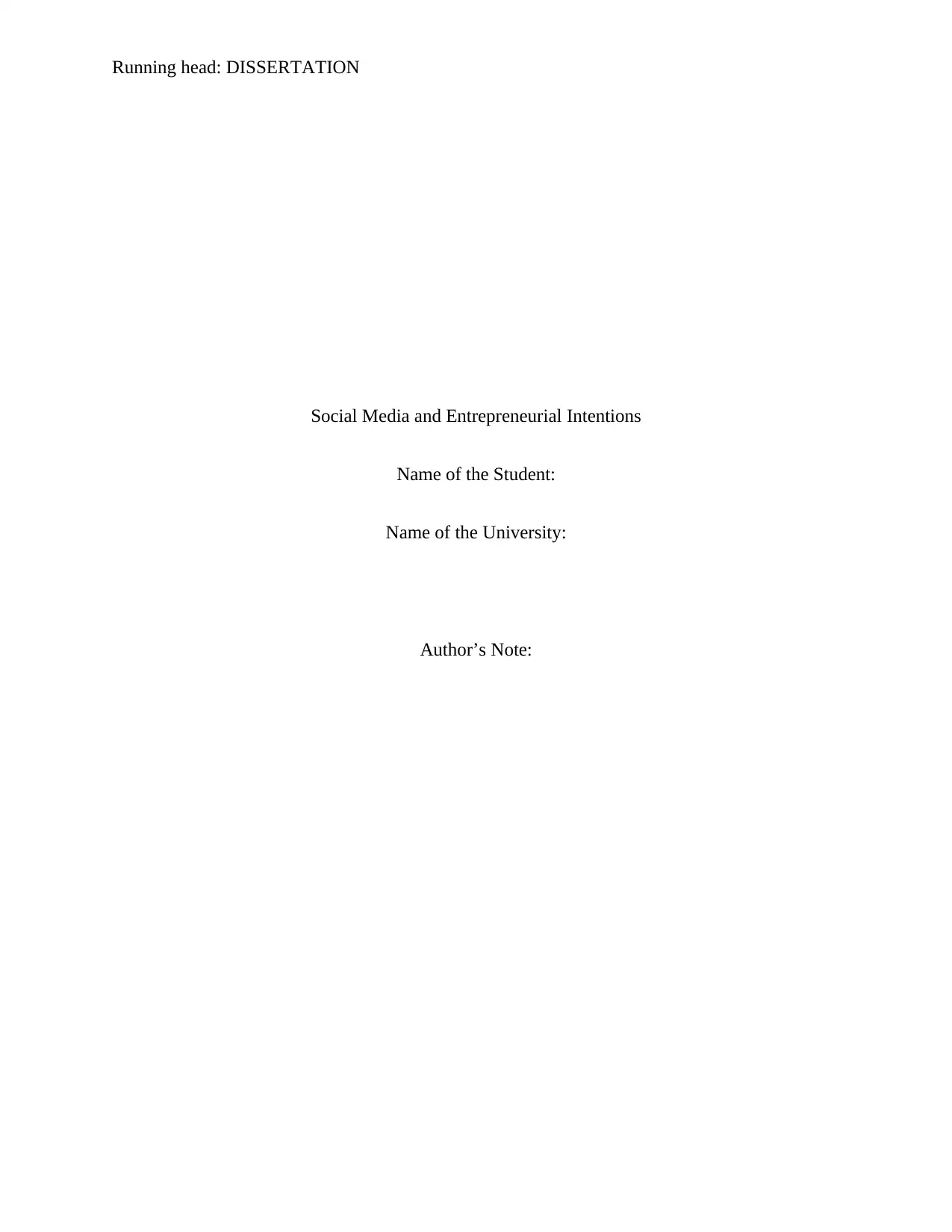
Running head: DISSERTATION
Social Media and Entrepreneurial Intentions
Name of the Student:
Name of the University:
Author’s Note:
Social Media and Entrepreneurial Intentions
Name of the Student:
Name of the University:
Author’s Note:
Paraphrase This Document
Need a fresh take? Get an instant paraphrase of this document with our AI Paraphraser
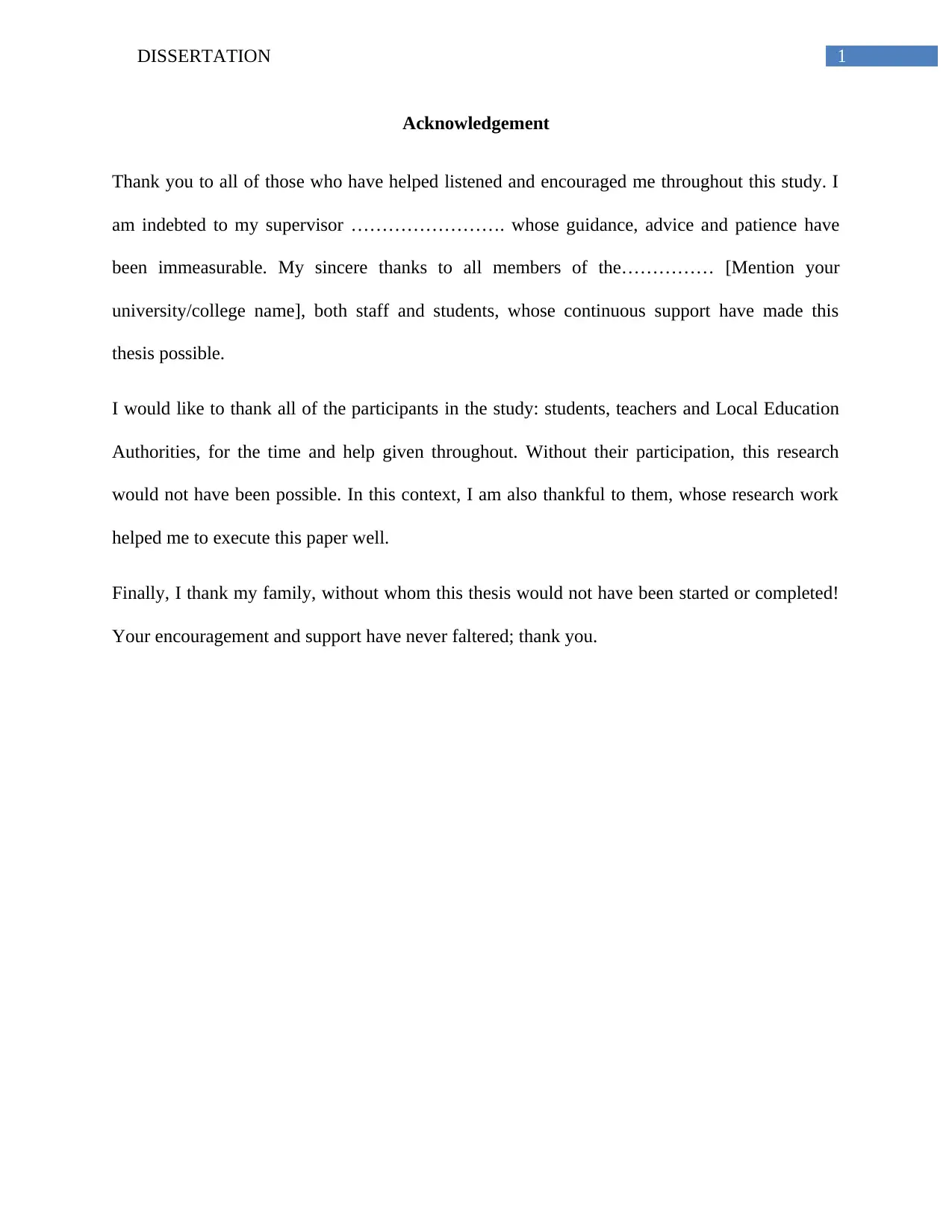
1DISSERTATION
Acknowledgement
Thank you to all of those who have helped listened and encouraged me throughout this study. I
am indebted to my supervisor ……………………. whose guidance, advice and patience have
been immeasurable. My sincere thanks to all members of the…………… [Mention your
university/college name], both staff and students, whose continuous support have made this
thesis possible.
I would like to thank all of the participants in the study: students, teachers and Local Education
Authorities, for the time and help given throughout. Without their participation, this research
would not have been possible. In this context, I am also thankful to them, whose research work
helped me to execute this paper well.
Finally, I thank my family, without whom this thesis would not have been started or completed!
Your encouragement and support have never faltered; thank you.
Acknowledgement
Thank you to all of those who have helped listened and encouraged me throughout this study. I
am indebted to my supervisor ……………………. whose guidance, advice and patience have
been immeasurable. My sincere thanks to all members of the…………… [Mention your
university/college name], both staff and students, whose continuous support have made this
thesis possible.
I would like to thank all of the participants in the study: students, teachers and Local Education
Authorities, for the time and help given throughout. Without their participation, this research
would not have been possible. In this context, I am also thankful to them, whose research work
helped me to execute this paper well.
Finally, I thank my family, without whom this thesis would not have been started or completed!
Your encouragement and support have never faltered; thank you.
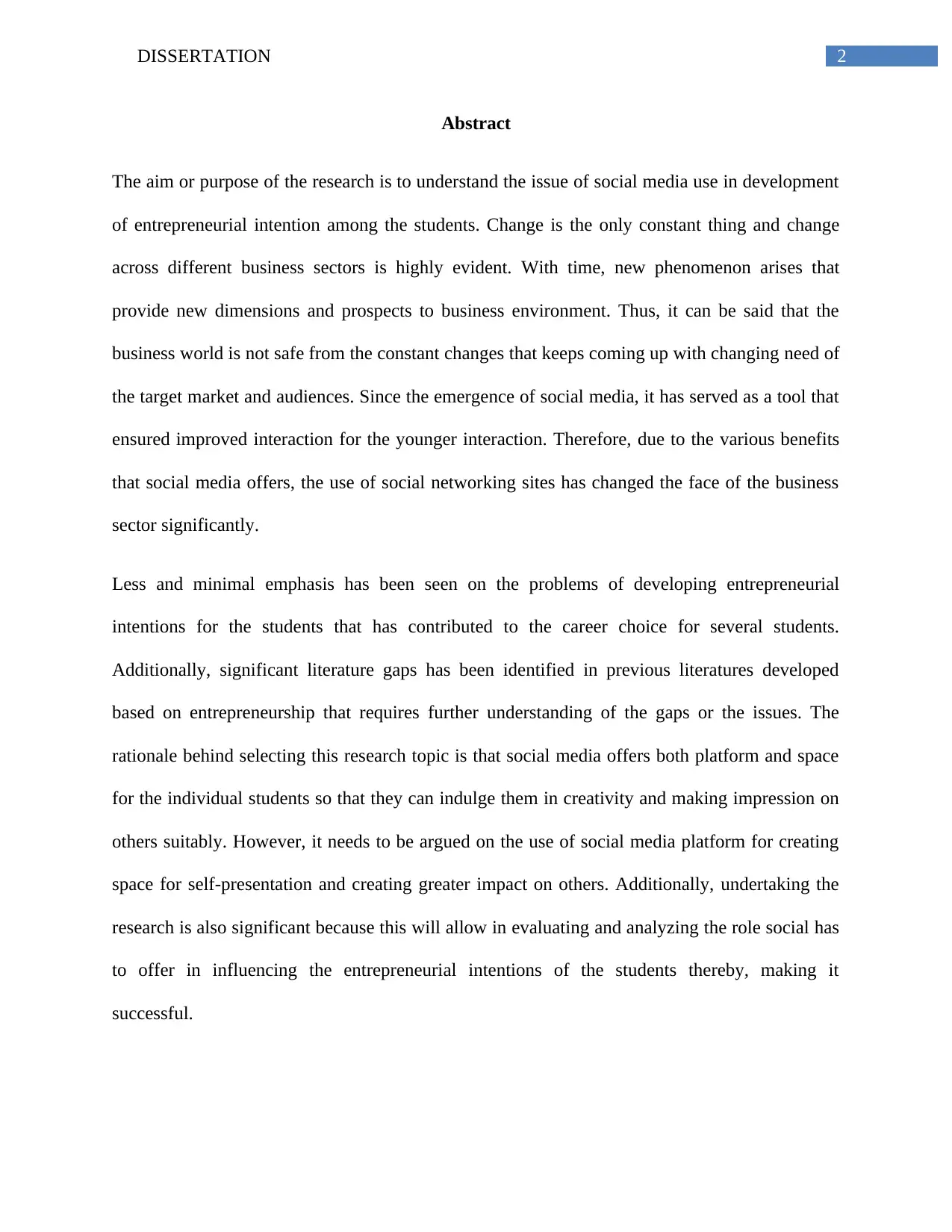
2DISSERTATION
Abstract
The aim or purpose of the research is to understand the issue of social media use in development
of entrepreneurial intention among the students. Change is the only constant thing and change
across different business sectors is highly evident. With time, new phenomenon arises that
provide new dimensions and prospects to business environment. Thus, it can be said that the
business world is not safe from the constant changes that keeps coming up with changing need of
the target market and audiences. Since the emergence of social media, it has served as a tool that
ensured improved interaction for the younger interaction. Therefore, due to the various benefits
that social media offers, the use of social networking sites has changed the face of the business
sector significantly.
Less and minimal emphasis has been seen on the problems of developing entrepreneurial
intentions for the students that has contributed to the career choice for several students.
Additionally, significant literature gaps has been identified in previous literatures developed
based on entrepreneurship that requires further understanding of the gaps or the issues. The
rationale behind selecting this research topic is that social media offers both platform and space
for the individual students so that they can indulge them in creativity and making impression on
others suitably. However, it needs to be argued on the use of social media platform for creating
space for self-presentation and creating greater impact on others. Additionally, undertaking the
research is also significant because this will allow in evaluating and analyzing the role social has
to offer in influencing the entrepreneurial intentions of the students thereby, making it
successful.
Abstract
The aim or purpose of the research is to understand the issue of social media use in development
of entrepreneurial intention among the students. Change is the only constant thing and change
across different business sectors is highly evident. With time, new phenomenon arises that
provide new dimensions and prospects to business environment. Thus, it can be said that the
business world is not safe from the constant changes that keeps coming up with changing need of
the target market and audiences. Since the emergence of social media, it has served as a tool that
ensured improved interaction for the younger interaction. Therefore, due to the various benefits
that social media offers, the use of social networking sites has changed the face of the business
sector significantly.
Less and minimal emphasis has been seen on the problems of developing entrepreneurial
intentions for the students that has contributed to the career choice for several students.
Additionally, significant literature gaps has been identified in previous literatures developed
based on entrepreneurship that requires further understanding of the gaps or the issues. The
rationale behind selecting this research topic is that social media offers both platform and space
for the individual students so that they can indulge them in creativity and making impression on
others suitably. However, it needs to be argued on the use of social media platform for creating
space for self-presentation and creating greater impact on others. Additionally, undertaking the
research is also significant because this will allow in evaluating and analyzing the role social has
to offer in influencing the entrepreneurial intentions of the students thereby, making it
successful.
⊘ This is a preview!⊘
Do you want full access?
Subscribe today to unlock all pages.

Trusted by 1+ million students worldwide
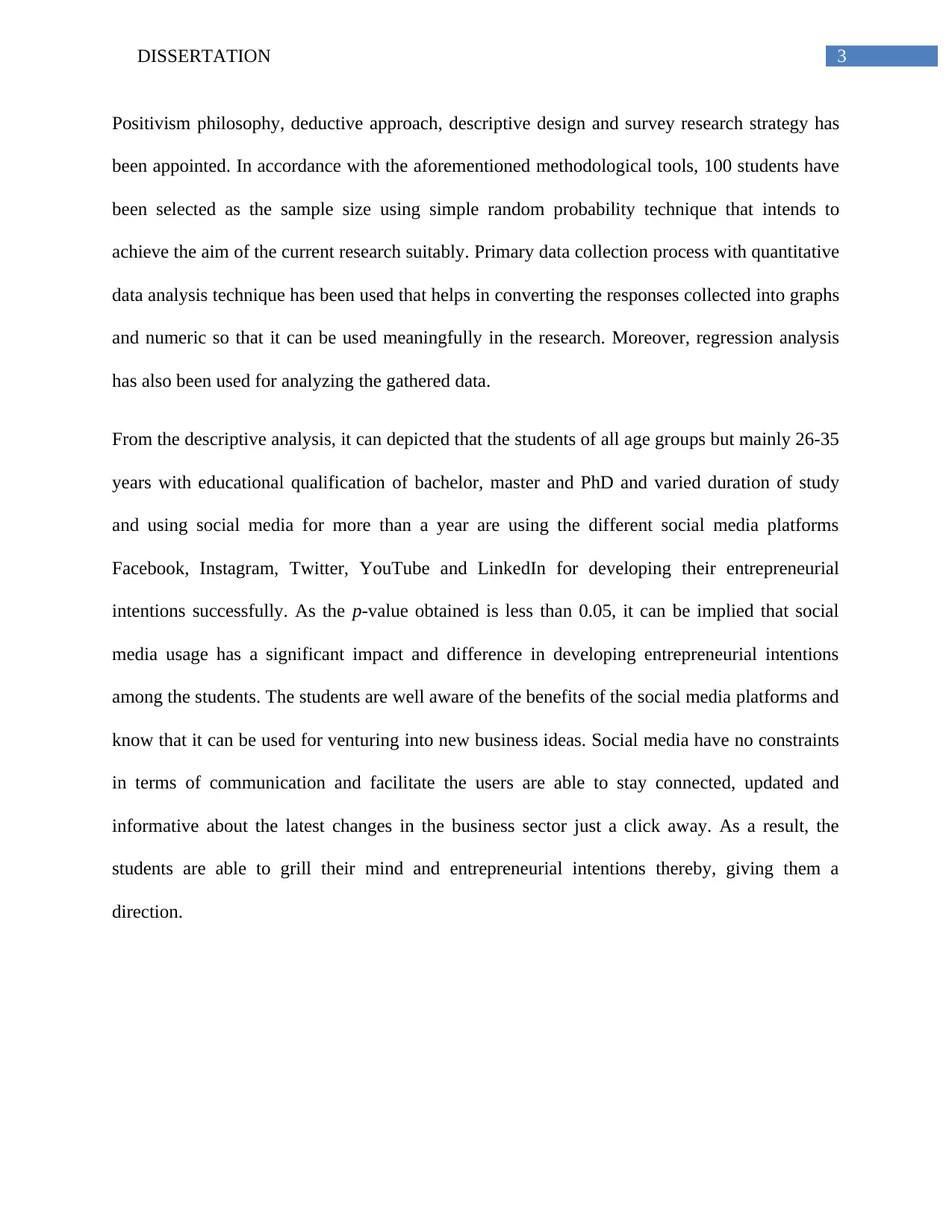
3DISSERTATION
Positivism philosophy, deductive approach, descriptive design and survey research strategy has
been appointed. In accordance with the aforementioned methodological tools, 100 students have
been selected as the sample size using simple random probability technique that intends to
achieve the aim of the current research suitably. Primary data collection process with quantitative
data analysis technique has been used that helps in converting the responses collected into graphs
and numeric so that it can be used meaningfully in the research. Moreover, regression analysis
has also been used for analyzing the gathered data.
From the descriptive analysis, it can depicted that the students of all age groups but mainly 26-35
years with educational qualification of bachelor, master and PhD and varied duration of study
and using social media for more than a year are using the different social media platforms
Facebook, Instagram, Twitter, YouTube and LinkedIn for developing their entrepreneurial
intentions successfully. As the p-value obtained is less than 0.05, it can be implied that social
media usage has a significant impact and difference in developing entrepreneurial intentions
among the students. The students are well aware of the benefits of the social media platforms and
know that it can be used for venturing into new business ideas. Social media have no constraints
in terms of communication and facilitate the users are able to stay connected, updated and
informative about the latest changes in the business sector just a click away. As a result, the
students are able to grill their mind and entrepreneurial intentions thereby, giving them a
direction.
Positivism philosophy, deductive approach, descriptive design and survey research strategy has
been appointed. In accordance with the aforementioned methodological tools, 100 students have
been selected as the sample size using simple random probability technique that intends to
achieve the aim of the current research suitably. Primary data collection process with quantitative
data analysis technique has been used that helps in converting the responses collected into graphs
and numeric so that it can be used meaningfully in the research. Moreover, regression analysis
has also been used for analyzing the gathered data.
From the descriptive analysis, it can depicted that the students of all age groups but mainly 26-35
years with educational qualification of bachelor, master and PhD and varied duration of study
and using social media for more than a year are using the different social media platforms
Facebook, Instagram, Twitter, YouTube and LinkedIn for developing their entrepreneurial
intentions successfully. As the p-value obtained is less than 0.05, it can be implied that social
media usage has a significant impact and difference in developing entrepreneurial intentions
among the students. The students are well aware of the benefits of the social media platforms and
know that it can be used for venturing into new business ideas. Social media have no constraints
in terms of communication and facilitate the users are able to stay connected, updated and
informative about the latest changes in the business sector just a click away. As a result, the
students are able to grill their mind and entrepreneurial intentions thereby, giving them a
direction.
Paraphrase This Document
Need a fresh take? Get an instant paraphrase of this document with our AI Paraphraser
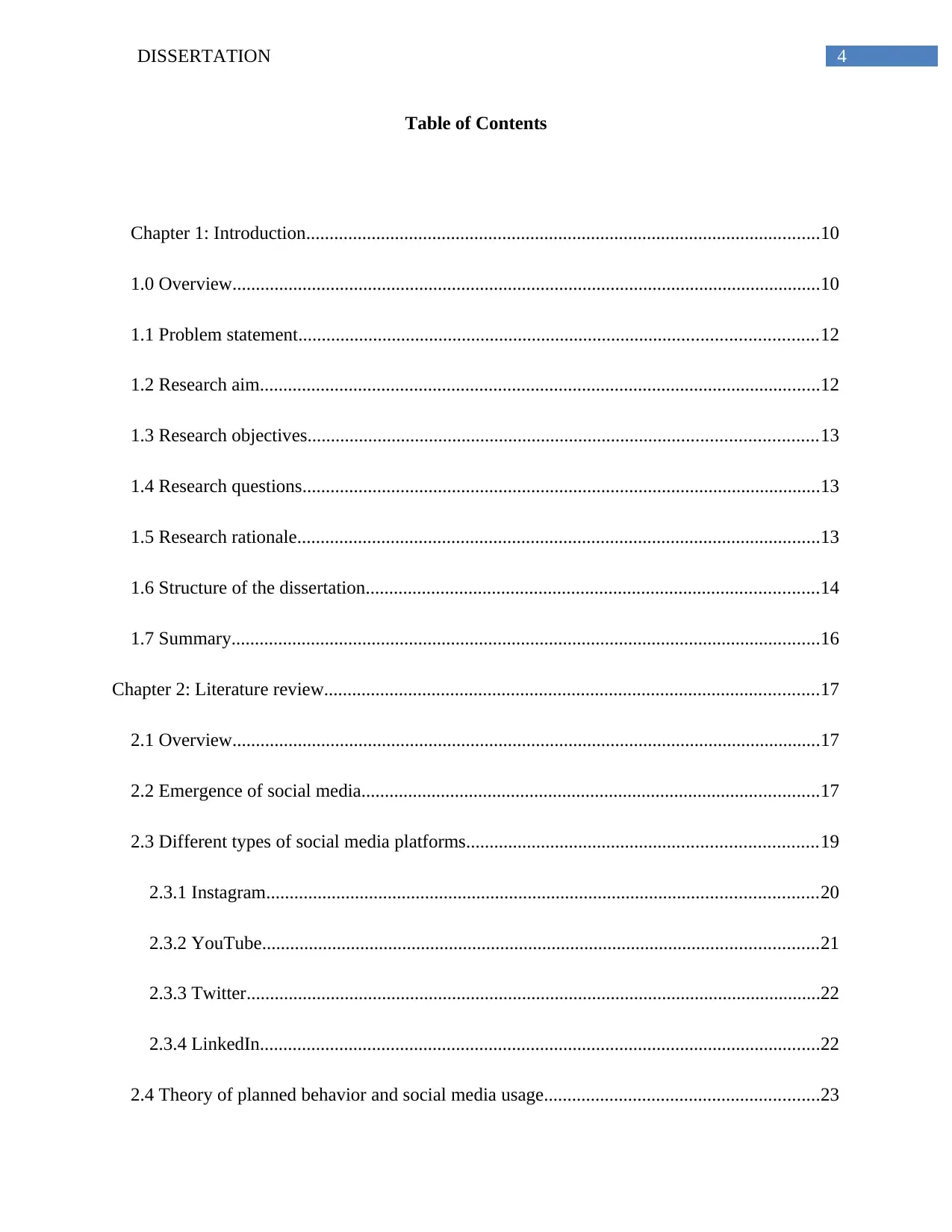
4DISSERTATION
Table of Contents
Chapter 1: Introduction..............................................................................................................10
1.0 Overview..............................................................................................................................10
1.1 Problem statement...............................................................................................................12
1.2 Research aim........................................................................................................................12
1.3 Research objectives.............................................................................................................13
1.4 Research questions...............................................................................................................13
1.5 Research rationale................................................................................................................13
1.6 Structure of the dissertation.................................................................................................14
1.7 Summary..............................................................................................................................16
Chapter 2: Literature review..........................................................................................................17
2.1 Overview..............................................................................................................................17
2.2 Emergence of social media..................................................................................................17
2.3 Different types of social media platforms...........................................................................19
2.3.1 Instagram......................................................................................................................20
2.3.2 YouTube.......................................................................................................................21
2.3.3 Twitter...........................................................................................................................22
2.3.4 LinkedIn........................................................................................................................22
2.4 Theory of planned behavior and social media usage...........................................................23
Table of Contents
Chapter 1: Introduction..............................................................................................................10
1.0 Overview..............................................................................................................................10
1.1 Problem statement...............................................................................................................12
1.2 Research aim........................................................................................................................12
1.3 Research objectives.............................................................................................................13
1.4 Research questions...............................................................................................................13
1.5 Research rationale................................................................................................................13
1.6 Structure of the dissertation.................................................................................................14
1.7 Summary..............................................................................................................................16
Chapter 2: Literature review..........................................................................................................17
2.1 Overview..............................................................................................................................17
2.2 Emergence of social media..................................................................................................17
2.3 Different types of social media platforms...........................................................................19
2.3.1 Instagram......................................................................................................................20
2.3.2 YouTube.......................................................................................................................21
2.3.3 Twitter...........................................................................................................................22
2.3.4 LinkedIn........................................................................................................................22
2.4 Theory of planned behavior and social media usage...........................................................23
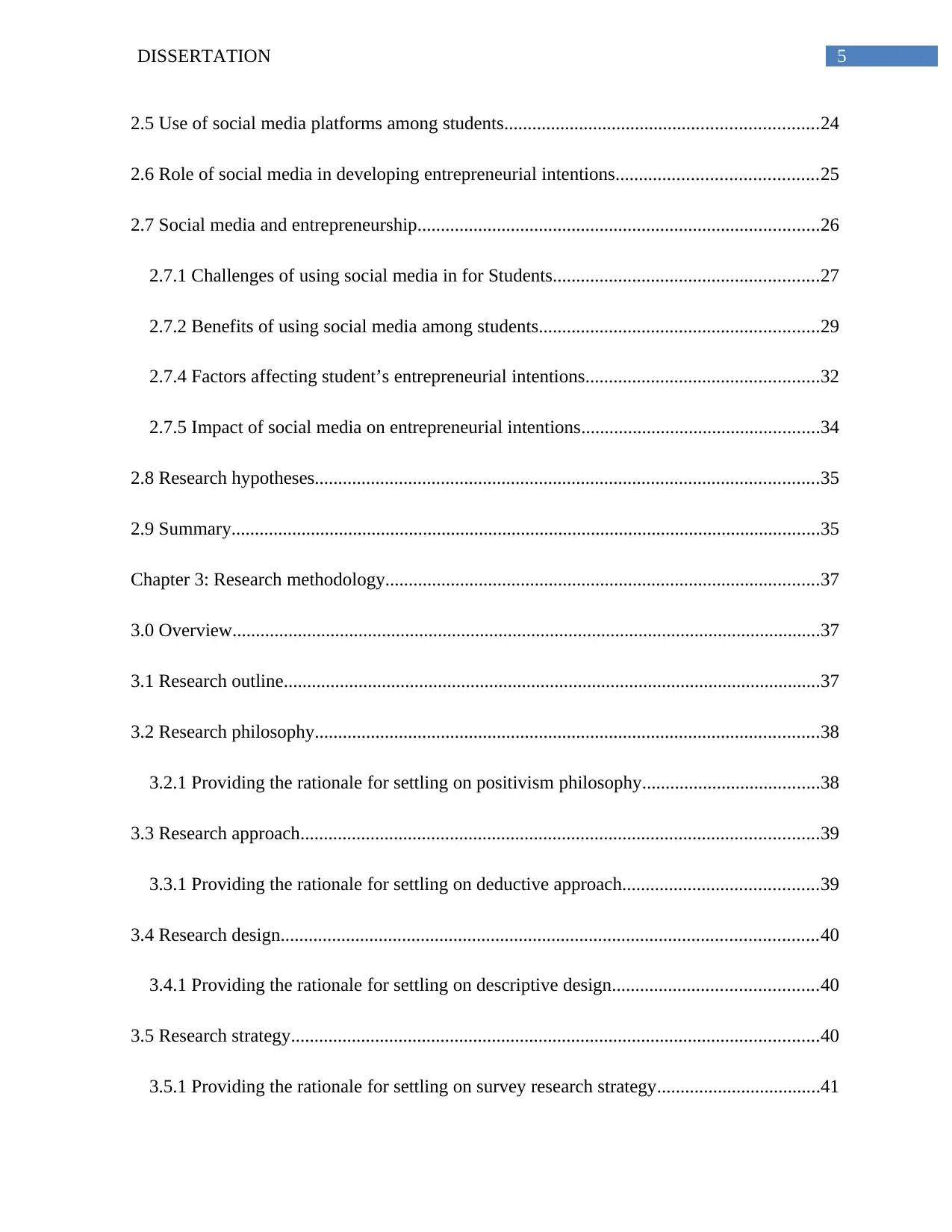
5DISSERTATION
2.5 Use of social media platforms among students...................................................................24
2.6 Role of social media in developing entrepreneurial intentions...........................................25
2.7 Social media and entrepreneurship......................................................................................26
2.7.1 Challenges of using social media in for Students.........................................................27
2.7.2 Benefits of using social media among students............................................................29
2.7.4 Factors affecting student’s entrepreneurial intentions..................................................32
2.7.5 Impact of social media on entrepreneurial intentions...................................................34
2.8 Research hypotheses............................................................................................................35
2.9 Summary..............................................................................................................................35
Chapter 3: Research methodology.............................................................................................37
3.0 Overview..............................................................................................................................37
3.1 Research outline...................................................................................................................37
3.2 Research philosophy............................................................................................................38
3.2.1 Providing the rationale for settling on positivism philosophy......................................38
3.3 Research approach...............................................................................................................39
3.3.1 Providing the rationale for settling on deductive approach..........................................39
3.4 Research design...................................................................................................................40
3.4.1 Providing the rationale for settling on descriptive design............................................40
3.5 Research strategy.................................................................................................................40
3.5.1 Providing the rationale for settling on survey research strategy...................................41
2.5 Use of social media platforms among students...................................................................24
2.6 Role of social media in developing entrepreneurial intentions...........................................25
2.7 Social media and entrepreneurship......................................................................................26
2.7.1 Challenges of using social media in for Students.........................................................27
2.7.2 Benefits of using social media among students............................................................29
2.7.4 Factors affecting student’s entrepreneurial intentions..................................................32
2.7.5 Impact of social media on entrepreneurial intentions...................................................34
2.8 Research hypotheses............................................................................................................35
2.9 Summary..............................................................................................................................35
Chapter 3: Research methodology.............................................................................................37
3.0 Overview..............................................................................................................................37
3.1 Research outline...................................................................................................................37
3.2 Research philosophy............................................................................................................38
3.2.1 Providing the rationale for settling on positivism philosophy......................................38
3.3 Research approach...............................................................................................................39
3.3.1 Providing the rationale for settling on deductive approach..........................................39
3.4 Research design...................................................................................................................40
3.4.1 Providing the rationale for settling on descriptive design............................................40
3.5 Research strategy.................................................................................................................40
3.5.1 Providing the rationale for settling on survey research strategy...................................41
⊘ This is a preview!⊘
Do you want full access?
Subscribe today to unlock all pages.

Trusted by 1+ million students worldwide
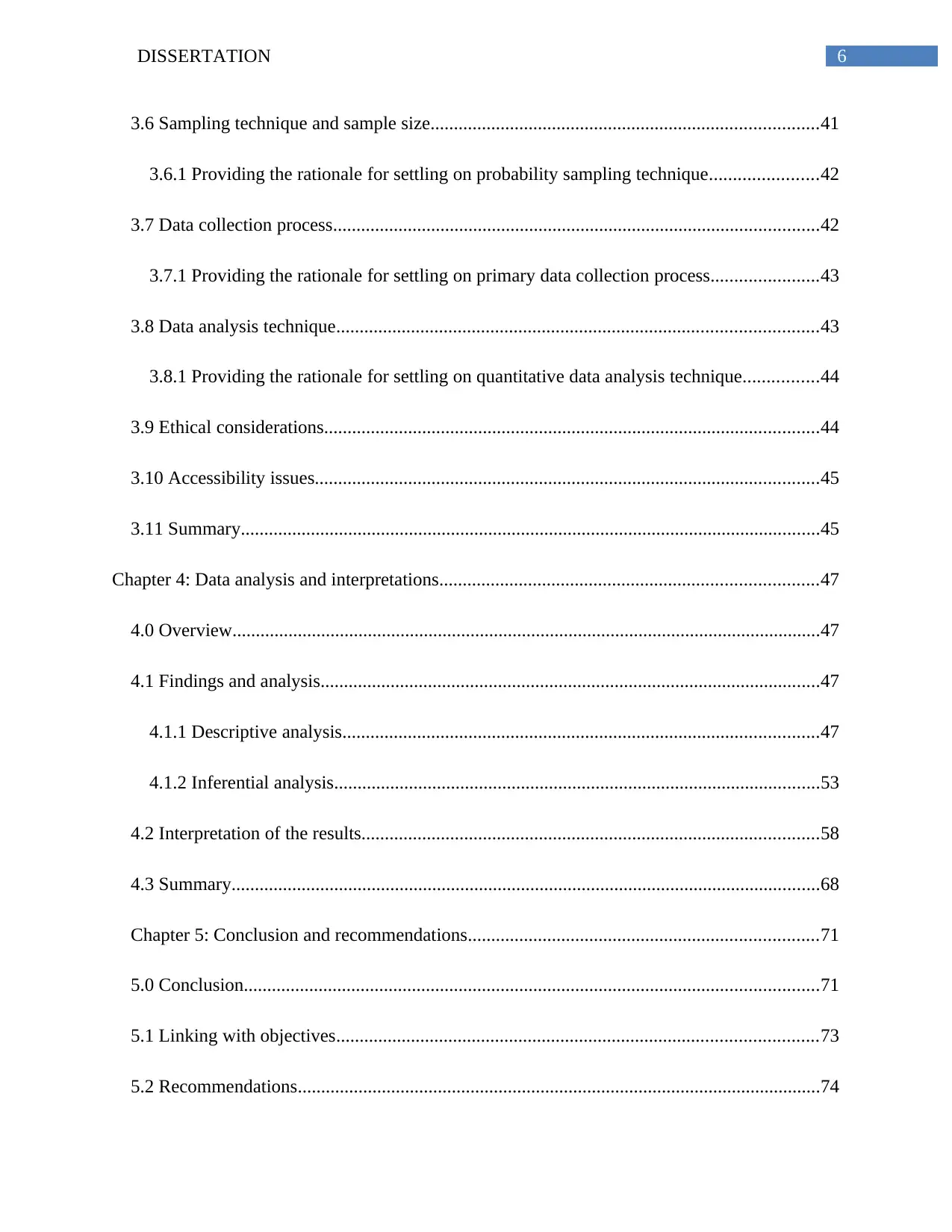
6DISSERTATION
3.6 Sampling technique and sample size...................................................................................41
3.6.1 Providing the rationale for settling on probability sampling technique.......................42
3.7 Data collection process........................................................................................................42
3.7.1 Providing the rationale for settling on primary data collection process.......................43
3.8 Data analysis technique.......................................................................................................43
3.8.1 Providing the rationale for settling on quantitative data analysis technique................44
3.9 Ethical considerations..........................................................................................................44
3.10 Accessibility issues............................................................................................................45
3.11 Summary............................................................................................................................45
Chapter 4: Data analysis and interpretations.................................................................................47
4.0 Overview..............................................................................................................................47
4.1 Findings and analysis...........................................................................................................47
4.1.1 Descriptive analysis......................................................................................................47
4.1.2 Inferential analysis........................................................................................................53
4.2 Interpretation of the results..................................................................................................58
4.3 Summary..............................................................................................................................68
Chapter 5: Conclusion and recommendations...........................................................................71
5.0 Conclusion...........................................................................................................................71
5.1 Linking with objectives.......................................................................................................73
5.2 Recommendations................................................................................................................74
3.6 Sampling technique and sample size...................................................................................41
3.6.1 Providing the rationale for settling on probability sampling technique.......................42
3.7 Data collection process........................................................................................................42
3.7.1 Providing the rationale for settling on primary data collection process.......................43
3.8 Data analysis technique.......................................................................................................43
3.8.1 Providing the rationale for settling on quantitative data analysis technique................44
3.9 Ethical considerations..........................................................................................................44
3.10 Accessibility issues............................................................................................................45
3.11 Summary............................................................................................................................45
Chapter 4: Data analysis and interpretations.................................................................................47
4.0 Overview..............................................................................................................................47
4.1 Findings and analysis...........................................................................................................47
4.1.1 Descriptive analysis......................................................................................................47
4.1.2 Inferential analysis........................................................................................................53
4.2 Interpretation of the results..................................................................................................58
4.3 Summary..............................................................................................................................68
Chapter 5: Conclusion and recommendations...........................................................................71
5.0 Conclusion...........................................................................................................................71
5.1 Linking with objectives.......................................................................................................73
5.2 Recommendations................................................................................................................74
Paraphrase This Document
Need a fresh take? Get an instant paraphrase of this document with our AI Paraphraser
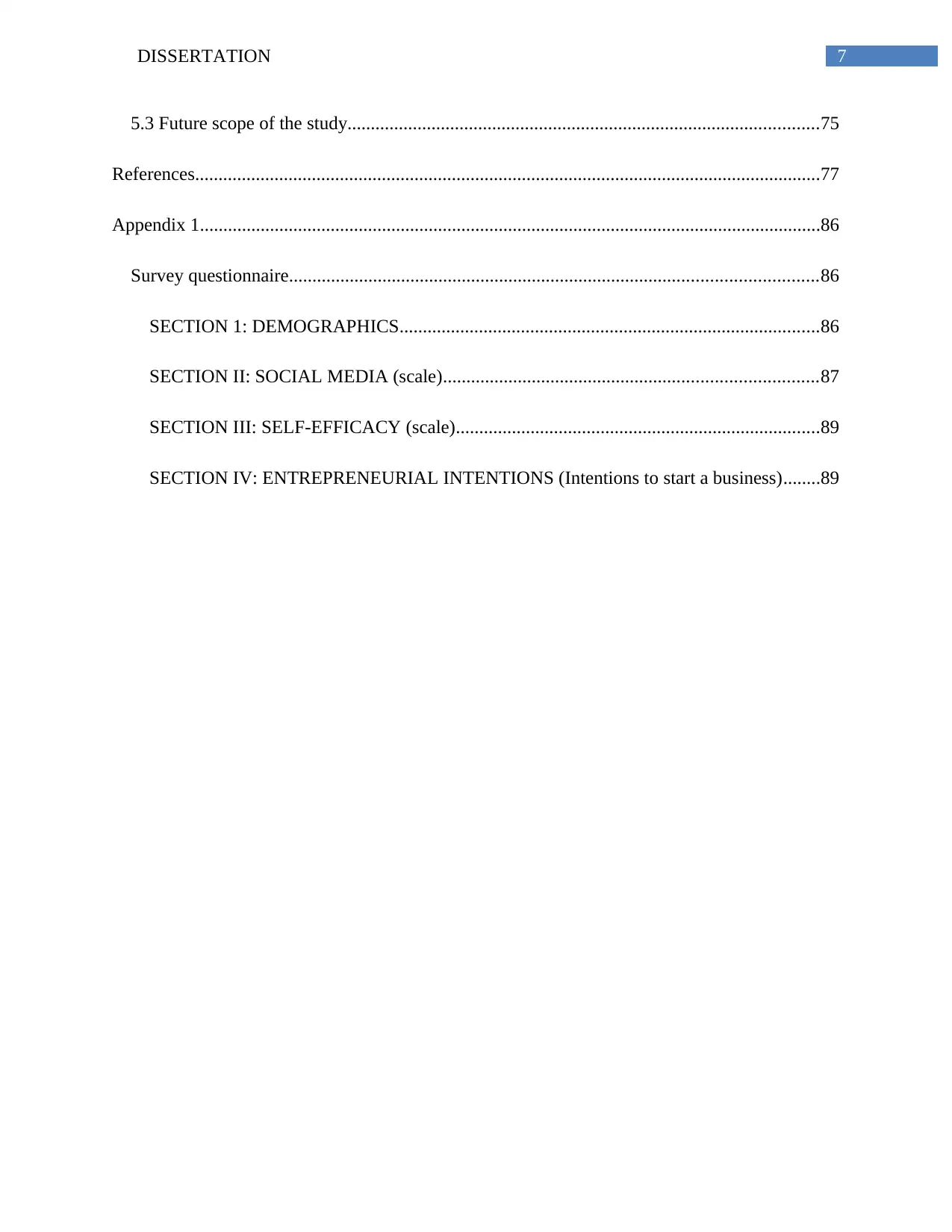
7DISSERTATION
5.3 Future scope of the study.....................................................................................................75
References......................................................................................................................................77
Appendix 1.....................................................................................................................................86
Survey questionnaire.................................................................................................................86
SECTION 1: DEMOGRAPHICS..........................................................................................86
SECTION II: SOCIAL MEDIA (scale)................................................................................87
SECTION III: SELF-EFFICACY (scale)..............................................................................89
SECTION IV: ENTREPRENEURIAL INTENTIONS (Intentions to start a business)........89
5.3 Future scope of the study.....................................................................................................75
References......................................................................................................................................77
Appendix 1.....................................................................................................................................86
Survey questionnaire.................................................................................................................86
SECTION 1: DEMOGRAPHICS..........................................................................................86
SECTION II: SOCIAL MEDIA (scale)................................................................................87
SECTION III: SELF-EFFICACY (scale)..............................................................................89
SECTION IV: ENTREPRENEURIAL INTENTIONS (Intentions to start a business)........89
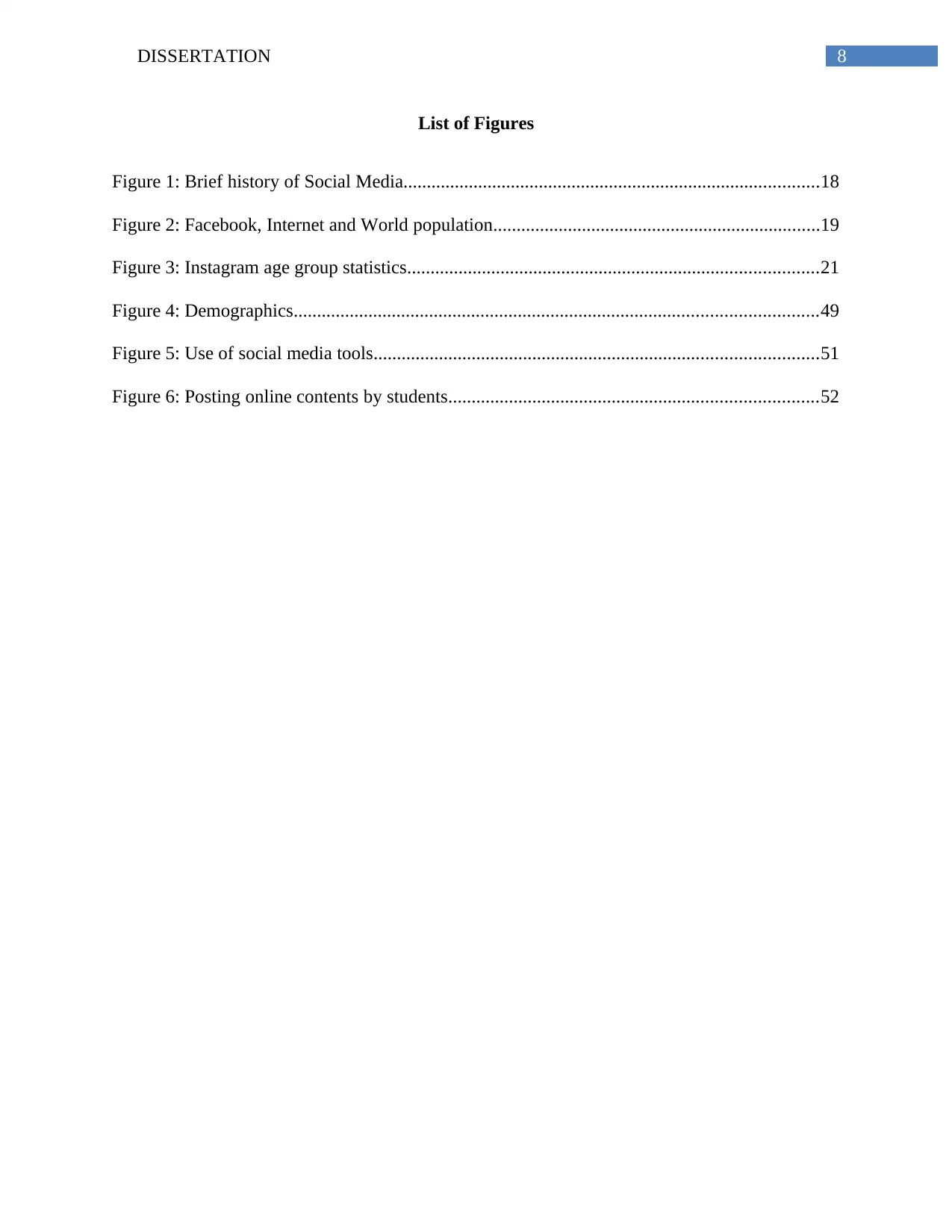
8DISSERTATION
List of Figures
Figure 1: Brief history of Social Media.........................................................................................18
Figure 2: Facebook, Internet and World population......................................................................19
Figure 3: Instagram age group statistics........................................................................................21
Figure 4: Demographics................................................................................................................49
Figure 5: Use of social media tools...............................................................................................51
Figure 6: Posting online contents by students...............................................................................52
List of Figures
Figure 1: Brief history of Social Media.........................................................................................18
Figure 2: Facebook, Internet and World population......................................................................19
Figure 3: Instagram age group statistics........................................................................................21
Figure 4: Demographics................................................................................................................49
Figure 5: Use of social media tools...............................................................................................51
Figure 6: Posting online contents by students...............................................................................52
⊘ This is a preview!⊘
Do you want full access?
Subscribe today to unlock all pages.

Trusted by 1+ million students worldwide

9DISSERTATION
List of Tables
Table 1: Regression analysis.........................................................................................................55
Table 2: Correlation analysis.........................................................................................................57
List of Tables
Table 1: Regression analysis.........................................................................................................55
Table 2: Correlation analysis.........................................................................................................57
Paraphrase This Document
Need a fresh take? Get an instant paraphrase of this document with our AI Paraphraser
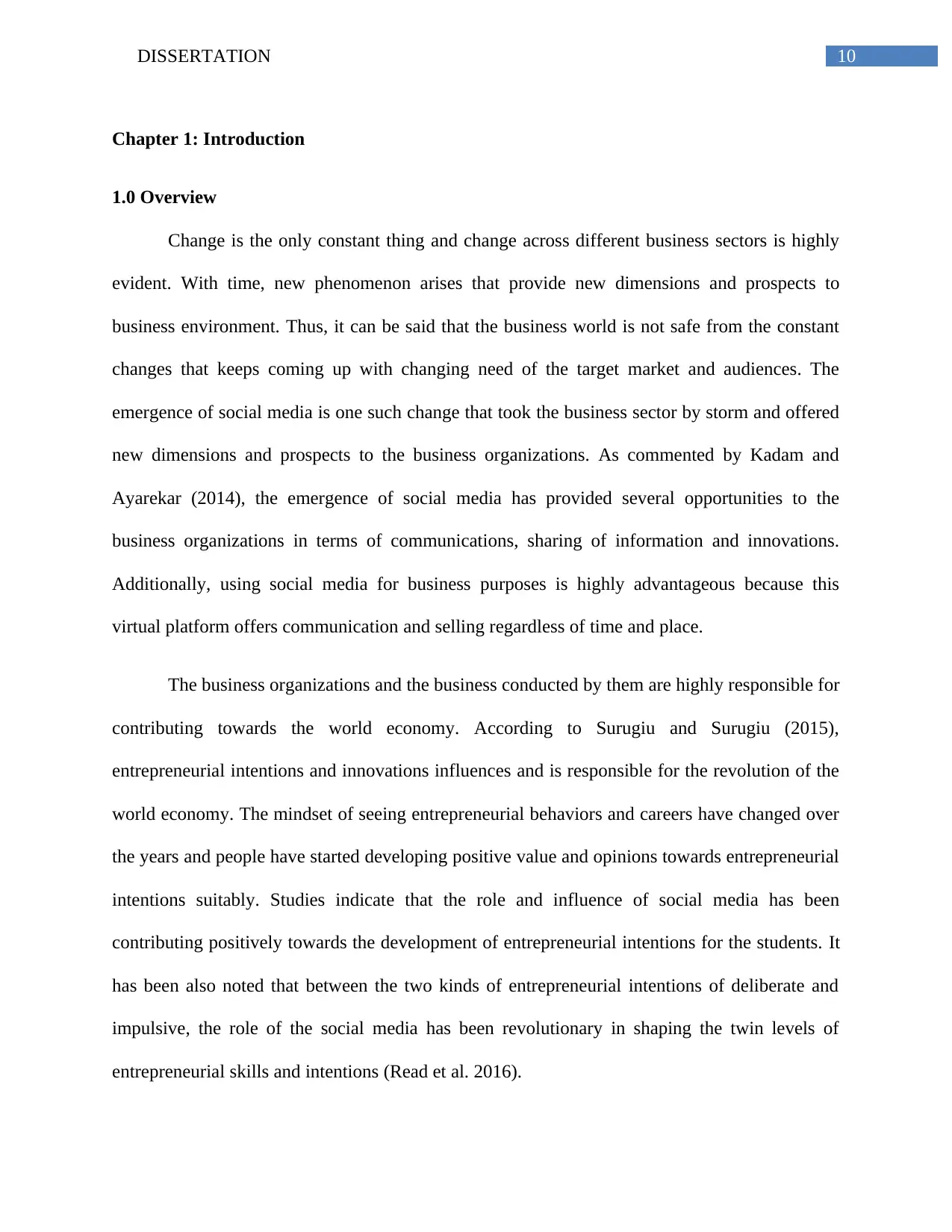
10DISSERTATION
Chapter 1: Introduction
1.0 Overview
Change is the only constant thing and change across different business sectors is highly
evident. With time, new phenomenon arises that provide new dimensions and prospects to
business environment. Thus, it can be said that the business world is not safe from the constant
changes that keeps coming up with changing need of the target market and audiences. The
emergence of social media is one such change that took the business sector by storm and offered
new dimensions and prospects to the business organizations. As commented by Kadam and
Ayarekar (2014), the emergence of social media has provided several opportunities to the
business organizations in terms of communications, sharing of information and innovations.
Additionally, using social media for business purposes is highly advantageous because this
virtual platform offers communication and selling regardless of time and place.
The business organizations and the business conducted by them are highly responsible for
contributing towards the world economy. According to Surugiu and Surugiu (2015),
entrepreneurial intentions and innovations influences and is responsible for the revolution of the
world economy. The mindset of seeing entrepreneurial behaviors and careers have changed over
the years and people have started developing positive value and opinions towards entrepreneurial
intentions suitably. Studies indicate that the role and influence of social media has been
contributing positively towards the development of entrepreneurial intentions for the students. It
has been also noted that between the two kinds of entrepreneurial intentions of deliberate and
impulsive, the role of the social media has been revolutionary in shaping the twin levels of
entrepreneurial skills and intentions (Read et al. 2016).
Chapter 1: Introduction
1.0 Overview
Change is the only constant thing and change across different business sectors is highly
evident. With time, new phenomenon arises that provide new dimensions and prospects to
business environment. Thus, it can be said that the business world is not safe from the constant
changes that keeps coming up with changing need of the target market and audiences. The
emergence of social media is one such change that took the business sector by storm and offered
new dimensions and prospects to the business organizations. As commented by Kadam and
Ayarekar (2014), the emergence of social media has provided several opportunities to the
business organizations in terms of communications, sharing of information and innovations.
Additionally, using social media for business purposes is highly advantageous because this
virtual platform offers communication and selling regardless of time and place.
The business organizations and the business conducted by them are highly responsible for
contributing towards the world economy. According to Surugiu and Surugiu (2015),
entrepreneurial intentions and innovations influences and is responsible for the revolution of the
world economy. The mindset of seeing entrepreneurial behaviors and careers have changed over
the years and people have started developing positive value and opinions towards entrepreneurial
intentions suitably. Studies indicate that the role and influence of social media has been
contributing positively towards the development of entrepreneurial intentions for the students. It
has been also noted that between the two kinds of entrepreneurial intentions of deliberate and
impulsive, the role of the social media has been revolutionary in shaping the twin levels of
entrepreneurial skills and intentions (Read et al. 2016).
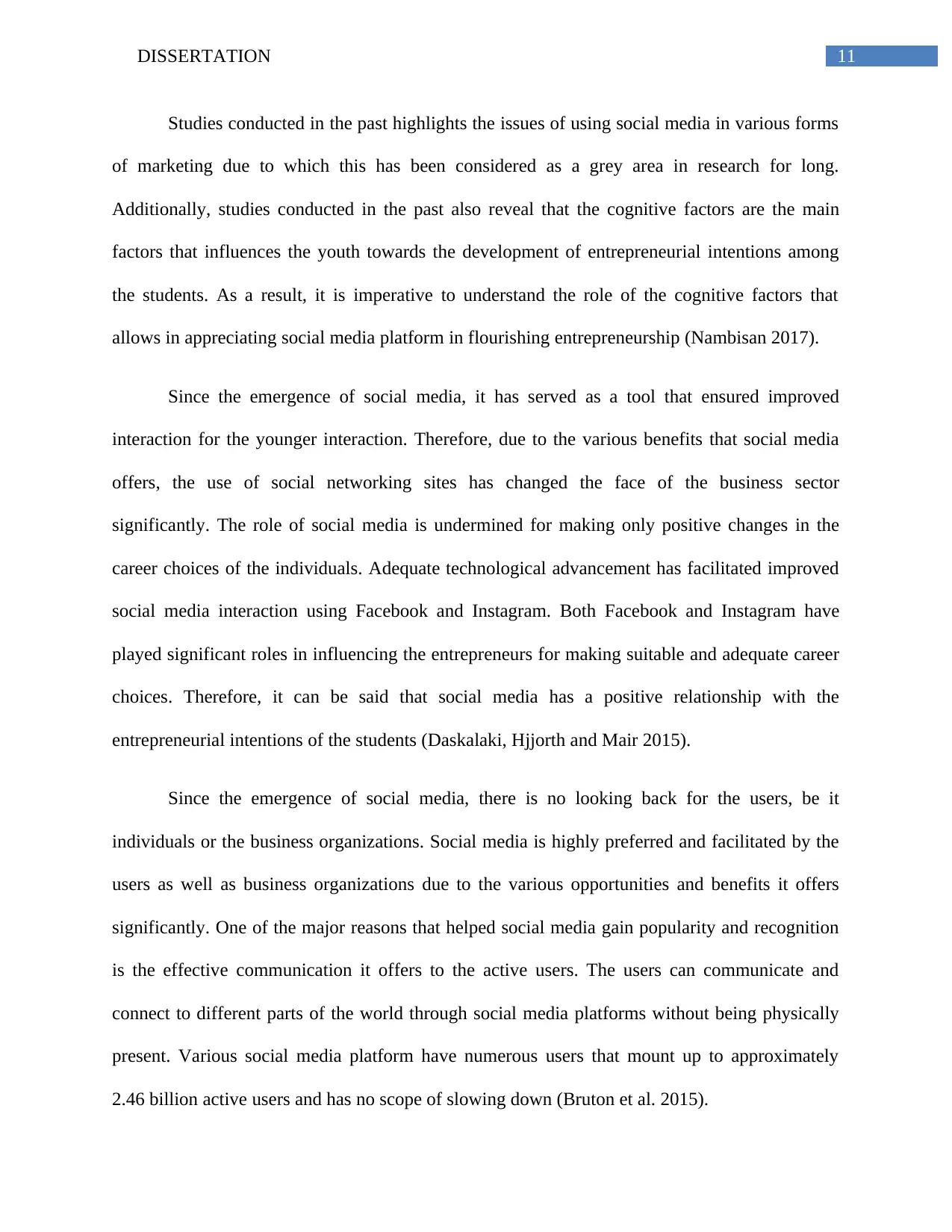
11DISSERTATION
Studies conducted in the past highlights the issues of using social media in various forms
of marketing due to which this has been considered as a grey area in research for long.
Additionally, studies conducted in the past also reveal that the cognitive factors are the main
factors that influences the youth towards the development of entrepreneurial intentions among
the students. As a result, it is imperative to understand the role of the cognitive factors that
allows in appreciating social media platform in flourishing entrepreneurship (Nambisan 2017).
Since the emergence of social media, it has served as a tool that ensured improved
interaction for the younger interaction. Therefore, due to the various benefits that social media
offers, the use of social networking sites has changed the face of the business sector
significantly. The role of social media is undermined for making only positive changes in the
career choices of the individuals. Adequate technological advancement has facilitated improved
social media interaction using Facebook and Instagram. Both Facebook and Instagram have
played significant roles in influencing the entrepreneurs for making suitable and adequate career
choices. Therefore, it can be said that social media has a positive relationship with the
entrepreneurial intentions of the students (Daskalaki, Hjjorth and Mair 2015).
Since the emergence of social media, there is no looking back for the users, be it
individuals or the business organizations. Social media is highly preferred and facilitated by the
users as well as business organizations due to the various opportunities and benefits it offers
significantly. One of the major reasons that helped social media gain popularity and recognition
is the effective communication it offers to the active users. The users can communicate and
connect to different parts of the world through social media platforms without being physically
present. Various social media platform have numerous users that mount up to approximately
2.46 billion active users and has no scope of slowing down (Bruton et al. 2015).
Studies conducted in the past highlights the issues of using social media in various forms
of marketing due to which this has been considered as a grey area in research for long.
Additionally, studies conducted in the past also reveal that the cognitive factors are the main
factors that influences the youth towards the development of entrepreneurial intentions among
the students. As a result, it is imperative to understand the role of the cognitive factors that
allows in appreciating social media platform in flourishing entrepreneurship (Nambisan 2017).
Since the emergence of social media, it has served as a tool that ensured improved
interaction for the younger interaction. Therefore, due to the various benefits that social media
offers, the use of social networking sites has changed the face of the business sector
significantly. The role of social media is undermined for making only positive changes in the
career choices of the individuals. Adequate technological advancement has facilitated improved
social media interaction using Facebook and Instagram. Both Facebook and Instagram have
played significant roles in influencing the entrepreneurs for making suitable and adequate career
choices. Therefore, it can be said that social media has a positive relationship with the
entrepreneurial intentions of the students (Daskalaki, Hjjorth and Mair 2015).
Since the emergence of social media, there is no looking back for the users, be it
individuals or the business organizations. Social media is highly preferred and facilitated by the
users as well as business organizations due to the various opportunities and benefits it offers
significantly. One of the major reasons that helped social media gain popularity and recognition
is the effective communication it offers to the active users. The users can communicate and
connect to different parts of the world through social media platforms without being physically
present. Various social media platform have numerous users that mount up to approximately
2.46 billion active users and has no scope of slowing down (Bruton et al. 2015).
⊘ This is a preview!⊘
Do you want full access?
Subscribe today to unlock all pages.

Trusted by 1+ million students worldwide
1 out of 92
Related Documents
Your All-in-One AI-Powered Toolkit for Academic Success.
+13062052269
info@desklib.com
Available 24*7 on WhatsApp / Email
![[object Object]](/_next/static/media/star-bottom.7253800d.svg)
Unlock your academic potential
Copyright © 2020–2025 A2Z Services. All Rights Reserved. Developed and managed by ZUCOL.





